26th August, 2025
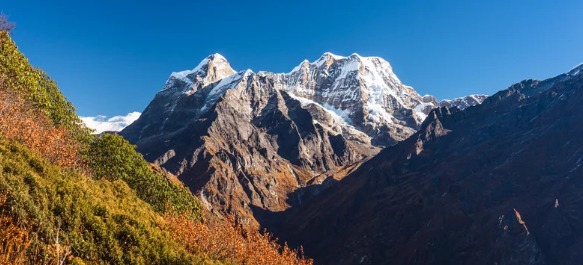
Feb 06, 2024
Mera Peak Climbing in October
- Is Mera Peak difficult to climb?
- Can a beginner climb Mera Peak?
- Highlights of the Mera Peak Climb in October
- Mera Peak Weather October
- Why Climb Mera Peak in October?
- Weather-related Difficulties in Mera Peak Climb
- Essential Tips for the Mera Peak Climb in October
- Is This Climbing Suitable For Me?
- Altitude Sickness and Acclimatization
- How Shall I Prepare Myself For The Mera Peak Expedition?
- Packing List For Mera Peak Climbing
- How Can I Cope With Altitude Sickness
- Conclusion
- Mera Peak Climbing Packages
Climbing Mera Peak in October presents an optimal opportunity to experience Nepal's Himalayas at their best. October marks the post-monsoon season when the weather is stable, skies are generally clear, and the landscapes are adorned with lush greenery and blooming rhododendrons, creating a picturesque backdrop for climbers.
The journey typically begins with a thrilling flight from Kathmandu to Lukla, where trekkers commence their trek through the heart of the Khumbu region. The trail passes through vibrant Sherpa villages like Namche Bazaar, renowned for its bustling market and stunning views of Thamserku and Kongde Ri. As climbers ascend towards Mera Peak, they traverse diverse terrain, including verdant forests, high alpine meadows, and rugged moraines, each offering unique glimpses into Nepal's natural beauty.

ISLAND PEAK SUMMIT RETURN BY HELICOPTER
Many of us only dream of standing on a tall peak looking down on the world. This is a great climb that will satisfy this desire. Island Peak, also referred to as Imja Tse, is a 6187-meter high peak in...
October's weather in the Everest region is mild and stable, ideal for trekking and climbing. Daytime temperatures at lower elevations range from comfortable to warm, while higher altitudes remain cool but pleasant during the day. Nights can be chilly, especially as climbers ascend to Mera Peak Base Camp and High Camp, where temperatures drop below freezing. Clear skies in October provide excellent visibility, offering panoramic views of Everest, Lhotse, Makalu, and other surrounding peaks from vantage points along the trek.
The ascent to Mera Peak itself involves navigating through glacier moraines and ascending snow slopes to the summit, which stands at 6,476 meters (21,247 feet). While technically non-technical, the climb requires basic mountaineering skills and proficiency in using crampons and ice axes. Experienced guides provide essential support, ensuring safety and guiding climbers through potential challenges like crevasses and varying weather conditions.
Overall, October offers a prime window for Mera Peak climbing, combining favorable weather, stunning landscapes, and a sense of achievement as climbers reach the summit and take in the breathtaking vistas of the Himalayas stretching into the horizon. It's a journey that blends adventure with natural beauty, making it a memorable experience for mountaineers seeking an unforgettable Himalayan expedition.
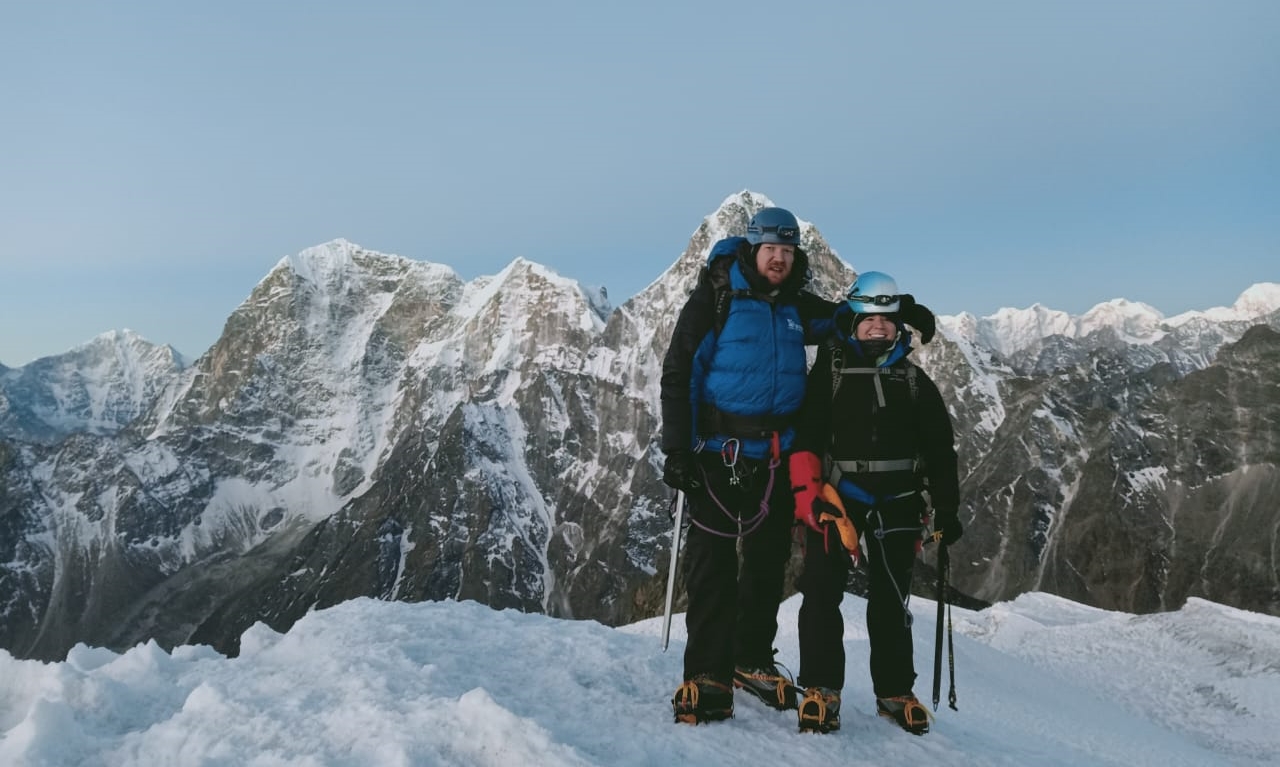
LOBUCHE PEAK CLIMBING
Lobuche East (6,119m/20,075ft), set in Nepal's stunning Khumbu on the Nepalese side of Everest.The best time to go trekking in Nepal is in Autumn (September-November) and in...
Is Mera Peak difficult to climb?
Climbing Mera Peak is considered challenging but achievable for climbers with basic mountaineering skills and good physical fitness. At 6,476 meters (21,247 feet), Mera Peak is Nepal's highest trekking peak and offers a non-technical ascent route. The climb involves trekking through varied terrain, including forests, moraines, and glaciers, before reaching High Camp. From there, climbers ascend a snow slope to the summit.
The difficulty of Mera Peak lies in its altitude and the physical demands of high-altitude trekking. Climbers must be prepared for long days of hiking, altitude acclimatization, and potentially harsh weather conditions. Basic mountaineering skills such as using crampons, ice axes, and ropes are necessary for navigating the glacier and ascending snow slopes safely.
With proper training, acclimatization, and guidance from experienced local guides, many climbers successfully reach the summit of Mera Peak each year. The challenge is rewarded with breathtaking views of Everest, Lhotse, Makalu, and other peaks of the Everest region, making it a memorable achievement for adventurers seeking to explore the Himalayas.
Can a beginner climb Mera Peak?
While Mera Peak is considered a challenging climb, it is suitable for beginners with a strong fitness level and determination. Unlike many Himalayan peaks, Mera Peak's standard route does not require advanced technical climbing skills. However, climbers should have prior trekking experience at high altitudes and be comfortable with basic mountaineering techniques.
Beginners planning to climb Mera Peak should undergo physical training to build stamina and endurance. Cardiovascular exercises, strength training, and hiking at high altitudes are recommended to prepare for the trek and summit push. Acclimatization is crucial to prevent altitude sickness and ensure a safe ascent.
Choosing a reputable trekking agency with experienced guides is essential for beginners. Guides provide valuable support, navigation skills, and safety measures throughout the climb. They assist in equipment rental, route planning, and monitoring weather conditions to optimize the climbing experience.
With proper preparation, determination, and support from experienced guides, beginners can successfully summit Mera Peak and enjoy the unparalleled beauty of the Himalayas from its summit.

ISLAND PEAK CLIMBING
Sherpa Expedition & Trekking (Est.1977) are pleased to announce FOR ADVENTURERS the most awesome, exhilarating & unforgettable climbing and treks on offer anywhere today!...
Highlights of the Mera Peak Climb in October
Climbing Mera Peak in October offers an extraordinary adventure amidst Nepal's post-monsoon landscapes. The trek begins with a scenic flight to Lukla followed by a trek through picturesque Sherpa villages and vibrant rhododendron forests. October's weather is stable with clear skies, providing optimal visibility of Everest, Lhotse, and Makalu from vantage points along the route.
Highlights of the climb include the gradual ascent through stunning landscapes, including high alpine meadows and rugged moraines. Trekkers experience the rich Sherpa culture in villages like Namche Bazaar and Pangboche, where ancient monasteries and traditional stone houses dot the landscape.
As climbers approach Mera Peak, they establish camps at strategic points for acclimatization before the final ascent. The climb involves crossing glaciers and ascending snow slopes, requiring basic mountaineering skills and the use of crampons and ice axes.
Reaching the summit of Mera Peak is a pinnacle moment, offering panoramic views of the Himalayas stretching into Tibet. Descending, climbers return through the heart of the Khumbu region, reflecting on their achievement and the natural beauty witnessed along the journey.
Overall, climbing Mera Peak in October combines physical challenge with breathtaking scenery and cultural immersion, making it a truly unforgettable Himalayan expedition.
Mera Peak Weather October
October is an excellent time to climb Mera Peak, offering favorable weather conditions in Nepal's Himalayas after the monsoon season. During October, the weather is generally stable with clear skies and mild temperatures, making it ideal for trekking and climbing. Daytime temperatures at lower elevations range from comfortable to mildly warm, while temperatures decrease as climbers ascend higher towards Mera Peak Base Camp and High Camp. Nights can be cold, especially at higher altitudes, requiring warm clothing and proper gear.
The stable weather in October provides excellent visibility for panoramic views of Everest, Lhotse, Makalu, and other surrounding peaks from various points along the trek. However, climbers should be prepared for occasional weather changes and potential snowfall, especially towards the latter part of the month.
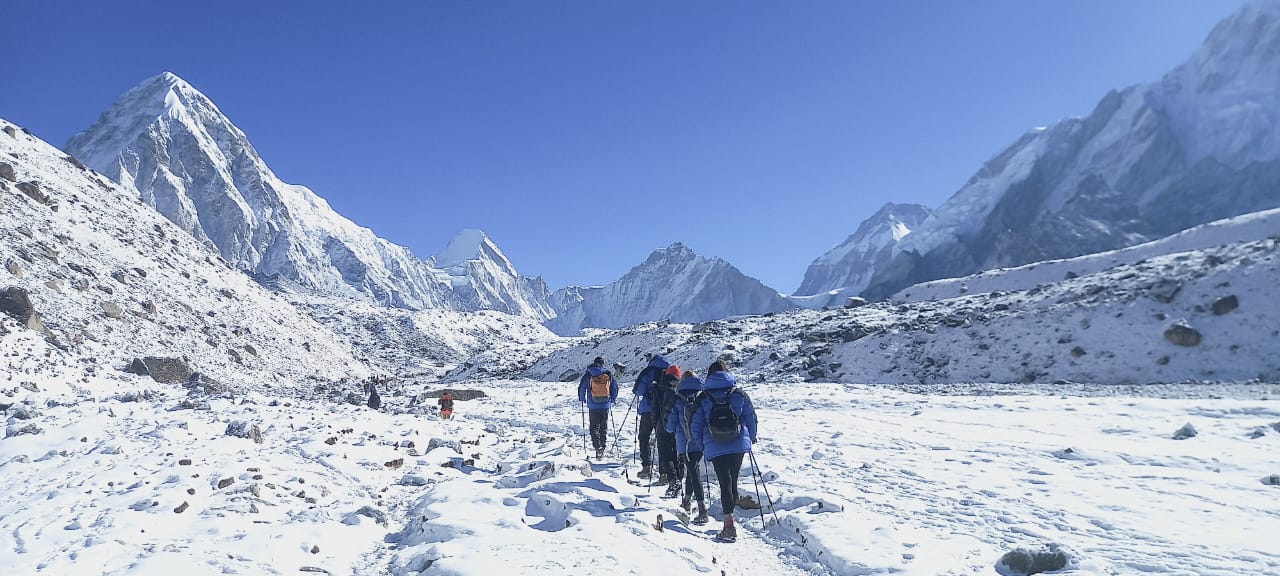
MERA AND ISLAND PEAK CLIMBING
Embark on a thrilling mountaineering adventure like no other with the Mera and Island Peak Climbing expedition crafted by We Sherpa Expedition and Trekking. This exclusive package is designed for adve...
Why Climb Mera Peak in October?
October is considered one of the best months to climb Mera Peak for several compelling reasons. The weather is generally stable and dry after the monsoon season, offering clear skies and optimal visibility of the stunning Himalayan landscapes. The temperatures are moderate, making trekking and climbing comfortable during the day, while cooler nights provide a refreshing contrast. The post-monsoon season also brings lush greenery and blooming rhododendrons, adding to the natural beauty of the trekking route.
Another advantage of climbing Mera Peak in October is the reduced risk of avalanches and other weather-related hazards compared to earlier months. The stable weather conditions and clearer skies enhance safety and enjoyment for climbers, allowing for a memorable experience without the extreme cold or heavy snowfall often encountered during winter months.
Weather-related Difficulties in Mera Peak Climb
While October generally offers stable weather for climbing Mera Peak, weather-related difficulties can still arise, especially at higher altitudes. Climbers should be prepared for cold temperatures, potential snowfall, and occasional wind gusts, particularly near Mera Peak's summit and high camps. Weather conditions can change rapidly in the mountains, requiring climbers to remain flexible with their plans and prepared with appropriate gear.
Challenges such as icy trails, slippery slopes, and reduced visibility due to fog or clouds may pose additional difficulties, necessitating caution and adherence to safety protocols. Monitoring weather forecasts and heeding advice from experienced guides are essential for navigating potential weather-related challenges during the climb.

MERA PEAK EXPEDITION 14 DAYS
The Mera Peak Expedition is a 14-day trek that offers a unique and challenging route to the summit of Mera Peak. The Upper Route is a less-traveled path that takes you through some of the most remote...
Essential Tips for the Mera Peak Climb in October
- Pack Wisely: Bring layers of clothing suitable for varying temperatures, including warm base layers, insulated jackets, waterproof outer layers, gloves, and hats. Don't forget sturdy trekking boots and gaiters for protection against snow and ice.
- Stay Hydrated: Drink plenty of water throughout the trek to stay hydrated, even in cooler temperatures. Consider using hydration packs or insulated water bottles to prevent liquids from freezing at higher altitudes.
- Acclimatize Properly: Take time to acclimatize at designated rest stops and high camps to prevent altitude sickness. Follow a gradual ascent schedule and listen to your body's signals.
- Safety First: Listen to weather updates and advice from guides. Be prepared to adjust plans based on weather conditions to ensure safety and maximize enjoyment of the climb.
- Enjoy the Journey: Take time to appreciate the stunning landscapes, local culture, and camaraderie with fellow climbers. Climbing Mera Peak in October offers a unique opportunity to experience Nepal's Himalayas at their most beautiful and serene.
Climbing Mera Peak in October combines adventure with breathtaking scenery, making it a highly rewarding experience for mountaineers seeking an unforgettable Himalayan expedition.

MERA PEAK EXPEDITION 13 DAYS
Mera Peak is one of the most popular and highest trekking peaks in Nepal, standing at 6,476 meters. The Mera Peak expedition is a 13-day trek that takes you through some of the most breathtaking scene...
Is This Climbing Suitable For Me?
Deciding if Mera Peak climbing is suitable involves considering several factors. While Mera Peak is technically non-technical, meaning it doesn't require advanced mountaineering skills, it does demand a good level of physical fitness and mental preparedness. The ascent involves trekking through varied terrain and ascending to high altitudes where oxygen levels are lower. Therefore, prior trekking experience and basic familiarity with using climbing gear like crampons and ice axes are beneficial.
It's essential to assess your fitness level and readiness for high-altitude trekking. Cardiovascular endurance, strength training, and practicing hiking at elevations are crucial preparations. Additionally, understanding the potential challenges such as altitude sickness and weather conditions is vital. Consulting with a healthcare professional before embarking on the expedition is recommended, especially for individuals with pre-existing medical conditions.
Altitude Sickness and Acclimatization
Altitude sickness, also known as acute mountain sickness (AMS), is a significant concern when climbing Mera Peak due to rapid altitude gain. Symptoms include headache, nausea, dizziness, and fatigue. Proper acclimatization is key to preventing AMS. This involves a gradual ascent with planned rest days at higher elevations to allow the body to adjust to reduced oxygen levels.
Hydration, adequate nutrition, and pacing yourself during the trek are essential for acclimatization. Climbers should ascend no more than 300-500 meters (984-1,640 feet) per day above 3,000 meters (9,842 feet) and include acclimatization hikes to higher elevations before returning to lower camps for sleep.
How Shall I Prepare Myself For The Mera Peak Expedition?
Preparing for the Mera Peak expedition requires physical conditioning, mental readiness, and logistical planning. Start with cardiovascular exercises such as hiking, running, or cycling to build endurance. Incorporate strength training to strengthen leg muscles and core stability, essential for carrying a pack and navigating uneven terrain.
Mental preparation involves understanding the challenges of high-altitude trekking, including potential weather changes, navigation through glaciers, and prolonged physical exertion. Familiarize yourself with basic mountaineering techniques, including the use of crampons, ice axes, and rope handling.
Logistically, ensure you have all necessary permits, travel insurance, and bookings with a reputable trekking agency. Arrange for proper gear including clothing layers for varying temperatures, sleeping bag suitable for cold conditions, and personal items like sunscreen, sunglasses, and a first aid kit.

MERA PEAK CLIMBING 17 DAYS
This is an excellent opportunity to climb Nepal’s highest peak without having to obtain a permit (6,476m/21,190ft). From the summit, you will have stunning views of several 8000m plus peaks, such as E...
Packing List For Mera Peak Climbing
Packing for Mera Peak climbing requires careful consideration of essential gear and clothing to ensure comfort, safety, and preparedness for changing weather conditions. Here's a comprehensive packing list:
- Clothing:
- Moisture-wicking base layers
- Insulated mid-layers (fleece or down jacket)
- Waterproof and windproof outer layers (jacket and pants)
- Trekking pants and shorts
- Warm hat and gloves
- Thermal socks and sturdy trekking boots
- Gear:
- Backpack (50-70 liters)
- Sleeping bag (rated for sub-zero temperatures)
- Sleeping pad or insulated mat
- Trekking poles
- Headlamp or flashlight with extra batteries
- Sunglasses with UV protection
- Climbing Equipment:
- Crampons
- Ice axe
- Climbing harness and helmet
- Rope (if necessary, depending on guiding arrangements)
- Personal Items:
- Sunscreen and lip balm with SPF
- Personal hygiene items (toothbrush, toothpaste, biodegradable soap)
- First aid kit with medications for altitude sickness, pain relief, and gastrointestinal issues
- Snacks and energy bars
- Water bottles or hydration system (consider insulated to prevent freezing)
- Miscellaneous:
- Travel documents (passport, permits)
- Cash (for tips, souvenirs, and emergencies)
- Camera or smartphone for capturing memories
Pack light but efficiently, considering weight restrictions and the need for carrying your own gear during the trek. Ensure all items are packed in waterproof bags or compartments to protect against rain or snow. Following this packing list will help you stay comfortable, safe, and prepared throughout your Mera Peak climbing expedition.

MERA PEAK CLIMBING 15 DAYS
The Mera Peak Expedition is a 15-day trek that takes you through some of the most stunning landscapes and challenging trails in Nepal. Mera Peak is the highest trekking peak in Nepal, standing at 6,47...
How Can I Cope With Altitude Sickness
Altitude sickness, also known as acute mountain sickness (AMS), can affect climbers ascending to high altitudes, including those attempting peaks like Mera Peak. Coping with altitude sickness involves several strategies to mitigate its effects and ensure a safe ascent:
- Gradual Acclimatization: Ascend slowly, allowing your body time to acclimatize to the reduced oxygen levels. Plan rest days at higher elevations to aid acclimatization.
- Hydration: Drink plenty of fluids to stay hydrated, as dehydration can exacerbate altitude sickness symptoms. Avoid alcohol and caffeinated beverages, which can contribute to dehydration.
- Medication: Consider carrying medications such as acetazolamide (Diamox) to prevent and treat altitude sickness symptoms. Consult with a healthcare professional for guidance on medication usage.
- Recognize Symptoms: Be aware of common symptoms of altitude sickness, including headache, nausea, dizziness, fatigue, and shortness of breath. Descend immediately if symptoms worsen despite rest and hydration.
- Proper Nutrition: Maintain a balanced diet rich in carbohydrates and easily digestible foods. Eating well helps maintain energy levels and supports overall health during the climb.
- Stay Warm: Keep yourself warm with appropriate clothing layers, especially during cold nights at higher altitudes. Cold temperatures can exacerbate altitude sickness symptoms.
- Communicate: Inform your guide or fellow climbers if you experience symptoms of altitude sickness. They can provide support and assistance as needed.
By following these strategies and listening to your body's signals, you can increase your chances of coping with altitude sickness effectively during your Mera Peak expedition.
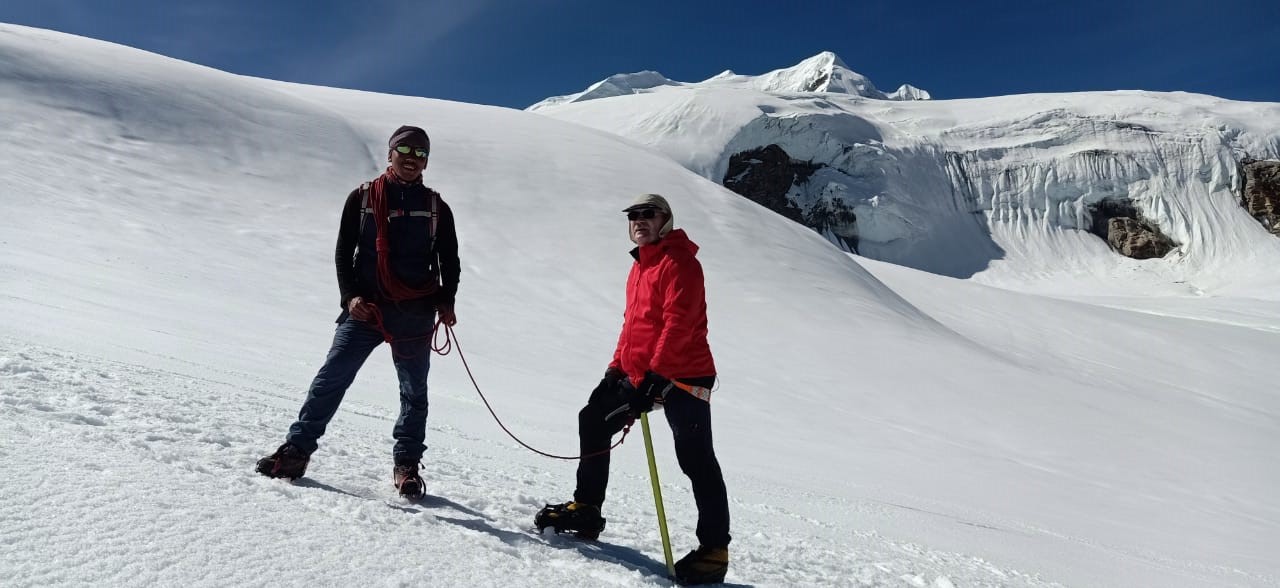
Mera Peak Climbing 20 Days
This is a chance to go climbing without the necessary permits that most climbing expeditions require in Nepal. Mera Peak fits the bill perfectly and at (6,476m/21,190ft) you will have spectacular view...
Conclusion
Embarking on a Mera Peak climbing expedition in Nepal offers a thrilling adventure amidst some of the world's most breathtaking landscapes. Whether you are a seasoned mountaineer or a trekking enthusiast seeking a challenging yet achievable goal, Mera Peak promises an unforgettable experience.
Preparation is key to success, encompassing physical conditioning, mental readiness, and logistical planning. Understand the demands of high-altitude trekking and acclimatization to mitigate risks such as altitude sickness. Pack wisely with essential gear and clothing suitable for varying weather conditions, ensuring comfort and safety throughout the journey.
During the climb, embrace the stunning views of Everest, Lhotse, and Makalu, and immerse yourself in the rich Sherpa culture of the Khumbu region. Engage with your fellow climbers, share stories, and celebrate each milestone as you progress towards the summit.
Ultimately, climbing Mera Peak is not just about reaching the top but also about the personal growth, resilience, and camaraderie forged along the way. Cherish the moments, challenge your limits, and savor the achievement of standing atop this majestic peak, knowing that you have conquered both the mountain and your own aspirations.
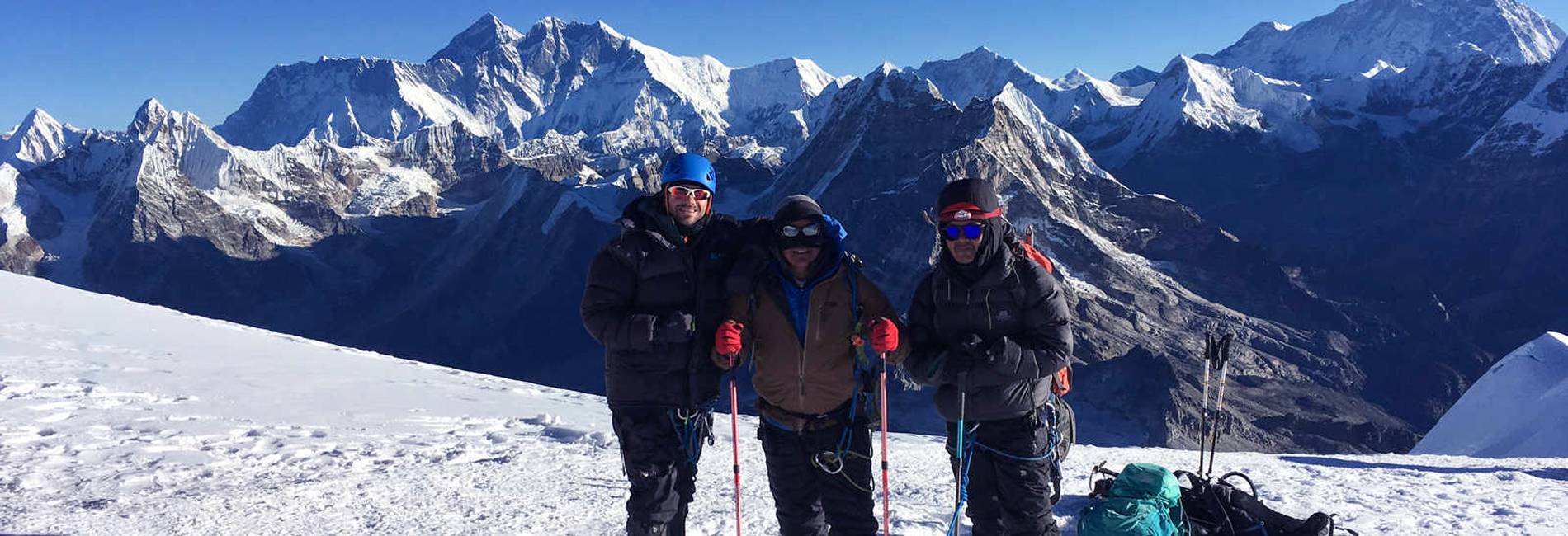
MERA PEAK CLIMBING
Mera Peak Climbing is an exhilarating adventure in Nepal that gives you an opportunity to reach the summit of Mera Peak at more than 6400m above sea level. Actually, it is the highest climbing (w...
Mera Peak Climbing Packages
Mera Peak Summit Return By Helicopter

MERA PEAK SUMMIT 10 DAYS
This is a chance to go climbing without the necessary permits that most climbing expeditions require in Nepal. Mera Peak fits the bill perfectly and at (6,476m/21,190ft) you will have spectacular view...
Any Questions? Let Us Know.
Recent Posts
17th June, 2025


















